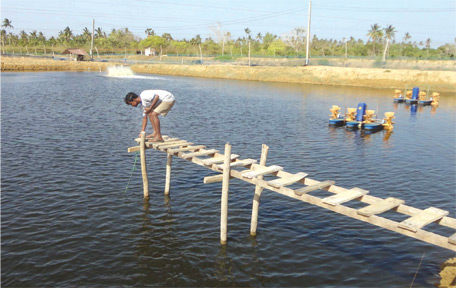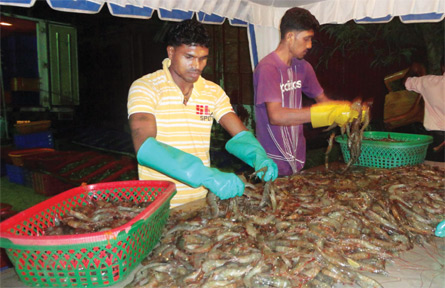Prawn exports hit 950 mt mark
The prawn farming industry netted in record profits by supplying
1,100 metric tons of prawns to the domestic market and 950 metric tons
to the export market, accruing large amounts of foreign exchange.
|

A prawn pond |
However, adequate research should be done on the outbreak of the
deadly viral diseases that ravage and infect shrimp farms especially in
the North Western province.
Significant losses were reported due to infected 'Mother brooders'
procured from 'cultured' prawn hatcheries that kill shrimps instantly
and potent vaccines are needed to curb the epidemic.
In the preceding years especially in the 1988-1998 period, 'White
spot disease' and other diseases which were lethal and contagious
spelled disaster, devastating a large number of farms which dotted the
Chilaw-Puttalam region and owned by enterprising prawn farmers.
Demand
It is common knowledge that 'Mother brooders' spawn baby prawns or
prawn-fry in hatcheries in large numbers as fishermen are unable to net
a good catch of mother brooders from the sea.
The hatchery owners are saddled with the problem of hatching baby
prawns on a regular basis. The supply of prawns does not meet demand
though there is no scarcity of prawn supplies to the wholesale market,
hotels and restaurants.
This was highlighted at a press conference under the aegis of the Sri
Lanka Aquaculture Development Alliance (SLADA) in connection with its
10th anniversary at the Ananthaya Hotel at Bangadeniya, Chilaw last
week.
It was emphasised that hatchery owners should breed quality 'Mother
prawns' to avert a possible outbreak of diseases, that are now
positively contained, with the available vaccines.
At present, prawn farming is carried out on 5,000 ha (hectares) and
the target is to produce 4,300 metric tons of prawns this year.
Infrastructure
Initially, the industry aimed at providing prawns to the export
market.
|

Aeration of a prawn pond |
With the improvement of the tourist industry, there is a great demand
for prawns in the local market. Supplies cannot be netted from the
lagoon and the sea alone.
Although this lucrative prawn farming is a money-spinner in terms of
foreign trade there are other constraints and setbacks encountered by
this industry. Adequate infrastructure facilities are the need of the
hour to develop prawn culture.
Another constraint is the expenditure incurred to provide electricity
to the prawn farms from the national grid and as such a large amount
money has to be set aside for electricity.
Though some farms run with electricity from the national grid, a
large amount of money is incurred by private farms which use generators
to power the motors aerating the ponds.
Nevertheless prawn farmers continue steadfastly undergoing extreme
hardship and insurmountable difficulties, it was revealed.
The Sri Lanka Aquaculture Development Alliance (SLADA) enables
farmers, hatcheries and value-chain firms to share their knowledge and
expertise to enhance the sustainability and productivity of the
industry. Better Management Practices (BMPs) with emphasis on
environmental protection and shrimp health are the key factors of this
strategy.
However, the recurrence of shrimp diseases remains the main
impediment to sustainable development of the industry particularly where
there is a need for resources and expertise to help farmers implement
better management practices (BMPs) effectively. Nevertheless, the
farmers plod on and control diseases to a great extent.
|

Grading of prawns for the commercial market. |
Shrimp farmers and stakeholders have cooperated with the project team
set up to develop locally adapted better-management practices (BMPs),
identifying local risk factors, limitations and impediments in distinct
zones and sub-zones of farming in the North Western and Eastern
Provinces.
B better management practices (BMPs) are the foundation for knowledge
sharing and reducing risks of production particularly those related to
diseases, it was revealed.
The Alliance monitors pathogens that cause noxious diseases affecting
the shrimps through additional laboratory capacity in the North Western
Province. Farmers and stakeholder industrialists jointly endeavour to
test the water quality in farm ponds and common water bodies.
The Alliance also shares the knowledge-base with interested
entrepreneurs regarding potential disease-outbreaks and to improve
bio-security by augmenting the production and enforcing better
farm-practices and technology.
The organisation also welcomes visitors to browse their
knowledge-resources and follow updates, events and information. The Sri
Lanka Aquaculture Development Alliance (SLADA) welcomes those engaged or
involved in any capacity in the shrimp farming industry in Sri Lanka to
join it.
President, Sri Lanka Aquaculture Development Alliance, Ajith Chandana
Perera and members Nimal Pathirana, S. Dayabaran, Rizwi Hanifa were also
present.
Text and pictures by Christie Fernando, Chilaw special cor. |

